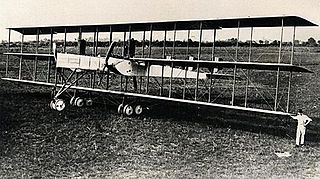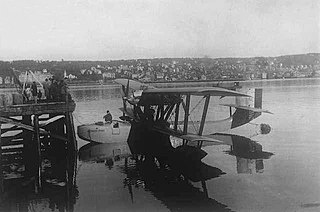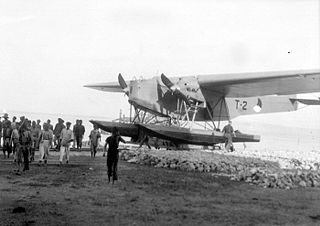Operators
 Kingdom of Italy
Kingdom of Italy
| SP.4 | |
|---|---|
| Role | Reconnaissance and bomber aircraft |
| National origin | Italy |
| Manufacturer | AER |
| Designer | Umberto Savoia and Ottorino Pomilio |
| First flight | 1917 |
| Number built | ca. 150 |
| Developed from | Savoia-Pomilio SP.1 |
The Savoia-Pomilio SP.4 was a reconnaissance and bomber aircraft built in Italy during the First World War. [1] It was a further development of the family of designs that had started with the SP.1. Ultimately all of these took their basic configuration from the Farman MF.11: a biplane with twin tails and a fuselage nacelle that accommodated the crew and a pusher-mounted engine. [2] However, the SP.4 differed both from its Farman antecedent and the previous Savoia-Pomilio designs by featuring twin engines mounted in the interplane gap in place of the single engine in the nacelle. [2] Removing the engine from this position allowed a second machine gun to be placed there instead. [2]
Apart from their intended role as a reconnaissance aircraft and bomber, some SP.4s were used to insert spies and saboteurs behind enemy lines. [3] A further development designated SP.5 remained unbuilt by the end of the war. [4]
Data from "Savoja-Pomilio S.p.4"
General characteristics
Performance
Armament

The Caproni Ca.4 was an Italian heavy bomber of the World War I era.

The Caproni Ca.1 was an Italian heavy bomber of the World War I era.

The Caproni Ca.2 was an Italian heavy bomber of the World War I era.

The Maurice Farman MF.11 Shorthorn is a French aircraft developed before World War I by the Farman Aviation Works. It was used as a reconnaissance and light bomber during the early part of World War I, later being relegated to training duties.

The CAC Woomera, also known as the CAC CA-4 and CAC CA-11, was an Australian bomber aircraft that was designed and constructed by the Commonwealth Aircraft Corporation during World War II. The order for the Woomera was cancelled before it became operational with the Royal Australian Air Force (RAAF).
The Savoia-Marchetti SM.88, was an Italian twin-engined, three-seat, heavy fighter prototype of World War II, featuring a twin-boom structure, and powered by German Daimler-Benz DB 601 engines.

The Savoia-Marchetti SM.91 was a two-seat, twin-engined, Italian heavy fighter prototype, designed to compete in a 1942 revision to a long-range fighter-bomber contract offered by the Regia Aeronautica to Italian aircraft companies in 1938. The original 1938 specification yielded the Savoia-Marchetti SM.88, which the SM.91 was largely based on.

The Savoia-Marchetti SM.78 was an Italian bomber/reconnaissance biplane flying boat of the early 1930s.

The Caproni Ca.97 was a civil utility aircraft produced in Italy in the late 1920s and early 1930s. As originally designed, it was a high-wing braced trimotor monoplane of conventional configuration with one engine mounted on the nose and the other two carried on strut-mounted nacelles at the fuselage sides. Examples were also produced with only the nose engine or only the two nacelle-mounted engines.

The Latham 47, or Latham R3B4 in Naval service was a French twin-engine flying boat designed and built by Société Latham & Cie for the French Navy. The aircraft achieved notoriety in 1928 when aircraft number 47.02 disappeared with the explorer Roald Amundsen on a rescue mission for the Italian explorer Umberto Nobile.

The Pomilio PE was a First World War Italian armed reconnaissance biplane designed and built by the Pomilio brothers. It was developed from the earlier Pomilio PC and PD.

The Savoia-Marchetti S.59 was a 1920s Italian reconnaissance/bomber flying boat designed and built by Savoia-Marchetti for the Regia Aeronautica.

The Fokker T.IV was a Dutch torpedo bomber/maritime reconnaissance floatplane of the 1920s and 1930s. First flying in 1927, it served with the Dutch Naval Aviation Service in the Dutch East Indies until the remaining aircraft were destroyed during the Japanese invasion in 1942.
The Gotha G.VII. a.k.a.GL.VII, was a bomber aircraft produced in Germany during the final months of World War I. With the strategic bombing campaign effectively over, it was intended to be a high-speed tactical bomber with a secondary reconnaissance capability. It was a conventional two-bay biplane design with tractor-mounted engines, and a conventional empennage with twin fins and rudders. The bombardier's position in the nose of the aircraft that had featured on earlier Gotha designs was removed, and the nose of the aircraft severely truncated and fitted with a streamlined nose-cone. This allowed the engines to be located further inboard than on previous designs, bringing them closer to the aircraft's centreline and therefore minimising the effects of asymmetric thrust in the event of an engine failure. The engine nacelles also featured careful streamlining.

The Gotha WD.14, WD.20, and WD.22 were a family of biplane torpedo bomber floatplanes developed in Germany during World War I.

The Italian Corpo Aeronautico Militare was formed as part of the Regio Esercito on 7 January 1915, incorporating the Aviators Flights Battalion (airplanes), the Specialists Battalion (airships) and the Ballonists Battalion. Prior to World War I, Italy had pioneered military aviation in the Italo-Turkish War during 1911–1912. Its army also contained one of the world's foremost theorists about the future of military aviation, Giulio Douhet; Douhet also had a practical side, as he was largely responsible for the development of Italy's Caproni bombers starting in 1913. Italy also had the advantage of a delayed entry into World War I, not starting the fight until 24 May 1915, but took no advantage of it so far as aviation was concerned.
The Macchi M.8 was an Italian reconnaissance/bomber flying boat designed by Alessandro Tonini and built by Macchi. It was used by the Italian Naval Aviation and was later flown by crews from the United States Navy.
The Savoia-Pomilio SP.1 was a reconnaissance and bomber aircraft built in Italy during the First World War.
The Savoia-Pomilio SP.2 was a reconnaissance and bomber aircraft built in Italy during the First World War. It was a refined version of the SP.1, and like it, took its basic configuration from the Farman MF.11: a biplane with twin tails and a fuselage nacelle that accommodated the crew and a pusher-mounted engine. The SP.2 entered mass production with SIA, and with co-designer Ottorino Pomilio's own firm that he had recently established.

The Savoia-Pomilio SP.3 was a reconnaissance and bomber aircraft built in Italy during the First World War.